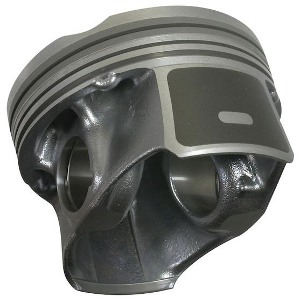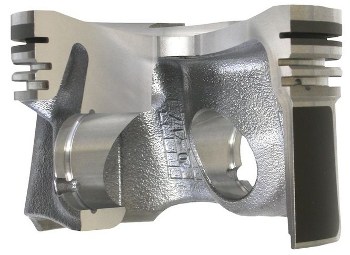 |
| August 07, 2012 | Volume 08 Issue 29 |
Designfax weekly eMagazine
Archives
Partners
Manufacturing Center
Product Spotlight
Modern Applications News
Metalworking Ideas For
Today's Job Shops
Tooling and Production
Strategies for large
metalworking plants
Wheels:
New 20% lighter piston is one key to downsizing gas engines

Federal-Mogul's Advanced Elastoval II piston.
Federal-Mogul Corporation has developed a lightweight, high-strength aluminum piston that aims to enable engine manufacturers to increase the power density and efficiency of boosted, direct-injected gasoline engines. The Advanced Elastoval II piston enters series production later this year in a new European passenger car (think BMW), where testing has shown that it contributes to significant gains in fuel economy and reductions in CO2 emissions.
The new Advanced Elastoval II piston is lighter, delivers increased power outputs, and can withstand the higher pressures that occur late in the combustion cycle of highly charged, downsized engines. In the coming years, Federal-Mogul design engineers say that specific power outputs will increase from current levels of around 95 kW/L to 130 kW/L. Peak combustion pressures will rise from 110 bar to 130 bar and even 160 bar in engines using alternative fuels like E100, compressed natural gas (CNG), or others.
"Federal-Mogul's innovative Advanced Elastoval II piston is lighter and better equipped to help deliver the higher power outputs our customers need to improve the CO2 emissions and fuel economy of gasoline powertrains," says Gian Maria Olivetti, vice president, technology and innovation, Federal-Mogul Powertrain Energy. "The application of our expertise to key technologies that enable the development of the next generation of downsized powertrains aligns with Federal-Mogul's strategy for sustainable, global profitable growth."
The Advanced Elastoval II piston architecture is up to 20% lighter than previous-generation pistons. Whereas previous wall sections measured 4 mm, the latest piston achieves wall sections as thin as 2.5 mm.

Cutaway of Federal-Mogul's Advanced Elastoval II piston.
"Any reduction in wall thickness requires the entire piston structure to be redesigned," says Arnd Baberg, chief engineer product engineering, Federal-Mogul Powertrain Energy. "Advances in piston design, analysis tools, and testing at Federal-Mogul's global development centers have led to a series of new features that achieve a better stress distribution, enabling a weight-optimized design."
The complex, curved side panel forms of the Advanced Elastoval II piston are inclined in two planes and are closer together at the top to support the piston crown, using multiple weight-reducing pockets and crown reinforcing ribs. The piston pin bosses are curved toward the side panels, and boss distance is reduced to the minimum possible. The piston's design uses asymmetric geometries to enable maximum weight reduction.
All Federal-Mogul Elastoval pistons use different skirt widths for the thrust and non-thrust sides of the piston to achieve the best compromise of lightweight, superior NVH (noise, vibration, and harshness) and scuffing performance. Advanced Elastoval II reduces skirt width to 50% of bore diameter on the thrust face and just 45% of the bore on the non-thrust face, without compromising NVH or increasing scuffing risk.
Several vehicle manufacturers are validating the Advanced Elastoval II piston, with the first scheduled for series production later this year.
Source: Federal-Mogul
Published August 2012
Rate this article
View our terms of use and privacy policy
